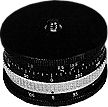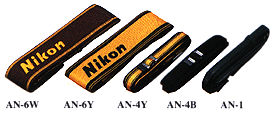
|
Modern
Classic SLRs Series : |

Panorama Head
With a 35, 50, or 105mm lens:
With a 28, 85, or 135mm lens:
The appropriate rotation for a 45mm lens is 40 degrees, and that for a 55mm lens is 35 degrees. Because of "wide-angle distortion" effects on the picture's edges, the use of lenses shorter than 28mm is not encouraged. The total number of exposures needed for complete 360 degree coverage is:
AP-2 Panorama Head
Because of "wide-angle distortion" effects on the picture's edges, the use of lenses shorter than 28mm is not encouraged. If you choose to use different focal lengths, use the next higher focal length. The total number of exposures needed for complete 360 degree coverage is:
This neck strap is made of black leatherette (Eslon) and is a misery-inducing 12mm wide and 2mm thick. The length may be adjusted out to 1 090mm (42 in.).


| Back | to Index page

Nikon F | Nikon F2 | Nikon F3 | Nikon F4 | Nikon F5 | Nikon F6 -not ready | Nikkormat / Nikomat | Nikon FM | Nikon FE/ FA | Nikon EM/FG/FG20 | Nikon Digital SLRs | Nikon - Other models Nikon Auto Focus Nikkor lenses:- Main Index Page
Nikon Manual Focus Nikkor lenses:- Fisheye-Nikkor Lenses - Circular | Full Frame | Ultrawides Lenses - 13mm15mm18mm20mm | Wideangle Lenses - 24mm28mm35mm | Standard Lenses - 45mm 50mm 58mm | Telephoto Lenses - 85mm105mm135mm180mm & 200mm | Super-Telephoto Lenses - 300mm 400mm 500mm 600mm 800mm 1200mm |
Index PageSpecial Application lenses:
Micro-Nikkor Lenses - 50mm~55mm -60mm 85mm -105mm 200mm Micro-Zoom 70-180mm
Perspective Control (PC) - 28mm 35mm PC-Micro 85mm
Dedicated Lenses for Nikon F3AF: AF 80mm f/2.8 | AF 200mm f/3.5 EDIF
Depth of Field Control (DC): 105mm 135mm
Medical Nikkor: 120mm 200mm
Reflex-Nikkor Lenses - 500mm 1000mm 2000mm
Others: Noct Nikkor | OP-Nikkor | UV Nikkor 55mm 105mm | Focusing Units | Bellows-Nikkor 105mm 135mm
Nikon Series E Lenses: 28mm35mm50mm100mm135mm | E-Series Zoom lenses: 36~72mm75~150mm70~210mm
MF Zoom-Nikkor Lenses: 25~50mm | 28~45mm | 28~50mm | 28~85mm | 35~70mm | 36~72mm E | 35~85mm | 35~105mm | 35~135mm | 35~200mm | 43~86mm | 50~135mm | 50~300mm | 70~210mm E | 75~150mm E | 80~200mm | 85~250mm | 100~300mm | 180~600mm | 200~400mm | 200~600mm | 360~1200mm | 1200~1700mm
Tele-Converters: TC-1 | TC-2 | TC-200 | TC-201 | TC-300 | TC-301 | TC-14 | TC-14A | TC-14B | TC-14C | TC-14E | TC-16 | TC-16A | TC-20ERecommended links to understand more technical details related to the Nikkor F-mount and production Serial Number:
http://www.zi.ku.dk/personal/lhhansen/photo/fmount.htm by: Hansen, Lars Holst
http://www.mir.com.my/rb/photography/hardwares/nikonfmount/lens2.htm
http://www.photosynthesis.co.nz/nikon/serialno.html| Message Board | for Nikon F Series SLR Camera(s)
| Message Board | for your Nikon Optics in a shared environment
| Message Board | Specifically tor Dispose or Looking for Nikon Photographic equipment| Nikkor Resources | NEW
H O M E
Home : Photography in Malaysia
Content and writeups: Copyright (R) Michael C. Liu, 1998.
Site design and graphic by: leofoo